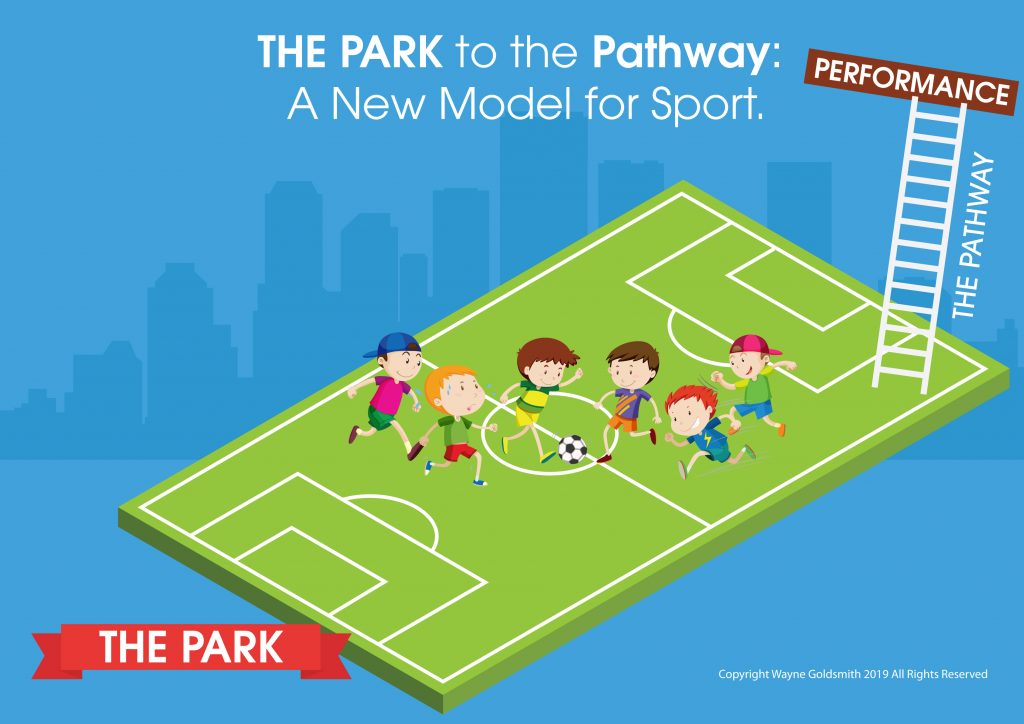Sports Participation and Performance: The Polarization of Sport.
Sports Participation and Performance: The Polarization of Sport.
By Wayne Goldsmith
Sport is notoriously polarized.
Usually that polarization is evident through the public rivalries in a sport’s fan base.
You either follow Liverpool OR Manchester United in the Premier League.
You love the Pittsburgh Steelers but you hate the Baltimore Ravens and vice versa in the NFL.
You either support Collingwood OR Hawthorn in Australia’s AFL.
You’re either an All Blacks Rugby Fan OR an English Rugby supporter.
But there’s a deeper, more concerning and more impactful sporting polarization that’s rapidly growing and it’s affecting every sport, every nation and every level of the sports industry.
The Polarization of Participation and Performance.
The Polarization Problem – the “EITHER – OR” Conundrum.
Here’s the basic problem right now.
Sport needed to change. It had to.
All over the world the evidence was unavoidable.
This has led to Governments, Sporting Organizations, Clubs and even Schools to challenge and change their traditional sports development pathways and move towards designing, developing and delivering more inclusive, more enjoyable, more engaging sports experiences.
Driven largely by changes in funding models, public pressures, media attention and the fear of seeing the alarming drop-out rates continuing to climb, most of the world’s sporting administrative bodies are moving away from the “everyone who starts playing a sport must be trained to be a professional player” type junior sports development philosophies.
The problem is, they are moving too far and too fast.
It’s become a bit of an EITHER – OR industry: you’re EITHER moving with the trends towards sport for fun, families and fitness which is focused on engagement, enjoyment and the experience of sport OR you’re a dinosaur still promoting the outdated performance based pathway models: You’re EITHER Pro-Participation OR you’re Pro-Performance.
Now don’t get me wrong.
For the past ten years, I’ve been a strong – almost radical, lone voice against the global obsession with the now discredited performance focused Pathway model.
But I’ve also been around long enough to see the “Lemmings” mentality I am observing around the world right now.
There are real dangers just up ahead if the industry continues down its current – excuse the pun – “path”.
Participation and Performance Polarization: How and Why Is this Happening?
One of the best phrases I’ve ever heard is this:
People don’t change until it’s too late or almost too late”
Government sporting agencies, National Sporting Organizations and other sports leaders knew sport was in trouble some time ago. I was getting data from clients and associations as far back at 2010 that many sports were experiencing significant declines in their grass roots sports participation levels.
As is the case in all areas of life, the first response from sports’ leaders was..deny deny deny.
Then we went through a period of blame blame blame.
“It’s the government’s fault”.
“It’s the school sport system”.
“It’s the Internet and Social media”.
“It’s parents today. They’re too busy to take an interest in their kids lives”.
Now finally, when some sports are showing catastrophic collapses in participation – finally – people are publicly admitting there’s a problem and starting to talk to seriously about fixing it.
More importantly, the sports industry leaders are now finally confessing to and owing the reality – it’s MY fault sport failed and it’s MY responsibility to fix it.
The Ridiculous Pathway Model: Every Kindergarten Child Will Become a Brain Surgeon.
For the past 15 years or so, sporting systems around the world were “married” to the Pathway model and the misguided belief that every kid who picked up a tennis racket needed to be placed on the “Pathway” to professional tennis and every kid who kicked a ball was on the “Pathway” to the English Premier League.
This resulted in coach education programs, athlete development programs and even officiating training and education programs all being focused on pushing and prodding every participant in sport along the mythical, magical Pathway towards high performance sporting success.
The implication of this was – and unfortunately still is – that kids who wanted to play sport for fun, for fitness, to make friends and to learn new things – i.e. THE VAST MAJORITY OF PARTICIPANTS – whether they liked it or not – were coached, developed and officiated with the underlying assumption that it was all part of sports’ Master plan to build and grow world class athletes.
As a colleague told me recently:
“The way sport runs is like telling every kindergarten kid to hold their crayon a specific way – a way which replicates the way a brain surgeon holds a scalpel because of the inevitability of that child – and every child becoming a brain surgeon one day. All the kid wants to do is draw pretty pictures of rainbows and kitties and butterflies and puppies and have fun drawing but the teacher comes along and says “No! Hold your crayon this way because it’s good training for when you become a brain surgeon”.
And we wonder why kids don’t want to play sport……………………..

Short Forms of Your Sport – They are Failing!
As this Pathway philosophy started to fail, smart people in nice suits from marketing companies sold Boards, Committees and even Governments a range of new, fast and fabulous short forms of traditional sport with a promise that these new more engaging and entertaining versions of sport would turn around falling participation rates and increase revenues.
So – once again – the “Lemming” mentality which exists in the sports industry and the blind commitment to bench-marking, “best-practice” and copying what everyone else is doing led to the proliferation of short versions of sport around the world.
And surprise surprise surprise…..these short forms of sport are already showing significant signs of failure.
Why?
Because – it’s no good coming up with a great solution to the wrong problem.
There was nothing wrong with sport – there’s nothing wrong with YOUR sport – it’s not the actual sport that’s the problem.
It’s the way we’re delivering sport that’s killing it.
Important Message to Boards, Committees and Executives – Don’t Fall for the Promises of Quick Fix Solutions! There isn’t any!
One thing that gets me angry is when I hear about and see the evidence of Boards, Committees and Executives falling for the same dumb stuff that’s failed sport in the past.
And the reason it makes me angry, is that the people trying to save their clubs and their sports at grass roots level end up being the ones who pay the price for poor leadership and ill-informed decision making…:“a fish rots from the head”.
There is NO quick fix solution.
There is NO change you can make which will deliver immediate results.
There is NOTHING you can buy – no program you can copy – no facility you can build – no software package you can download that will solve your problems in sports participation.
You have got to finally accept the fact that to survive you need to become a “client-focused” organization and deliver quality experiences for kids and families and all your stakeholders which are enjoyable, engaging, meaningful and personally rewarding.
You need to shift from the outdated concept of coming up with “one-size-fixes-all” programs and focus instead of delivering sports experiences in partnership with local, district and regional level sporting organizations and people working at the grass roots of your sport.
“Trickle-down” sport does not work. Time after time sporting organizations and government agencies come up with some all new, all singing, all dancing new program with a great acronym, fund it heavily then roll it out across the national sporting system telling people it’s the panacea to all of their problems. IT DOES NOT WORK.
You have to “de-power” yourselves and empower the people working in their communities around your nation, invest in their capability to lead themselves…“a rising tide lifts all the boats”.
And the first thing you have to do, is get rid of your commitment to the ridiculous Pathway model.
Sports Participation AND Performance: It’s Possible to Do Both and Do Them Both Well.
The bottom line is this: The only athlete who can’t improve….is the one who isn’t coming!
It is logical that before an organization or club or coach can ever think about developing a sports performance model, they need to build a strong and sustainably stable base of participants (and their families) who love what they do – and do what they love.
In reality, the development of athletes is not an EITHER – OR proposition: it’s an AND!
To thrive, sporting organizations need to connect and engage with their participants and consistently deliver safe, quality, enjoyable learning and playing environments.
They need to be “that” sport: the sport that parents and kids and carers are all talking about, texting about, posting about as an experience they enjoy, they value and that they want to share.
But, there are also kids who are genuinely aspirational: driven not by the wishes and whims of their parents or overzealous coaches – but by their own deeply held motivations and precious dreams.
Those kids now – and in the future – as they have done so in the past, will search out competitive opportunities, will dare to be different, will seek to get better and will strive for success.
It is important that whilst sports are quite rightly changing the way they deliver the experience of sport and embrace more “client-focused” sporting products and programs, they do not lose sight of the importance of providing performance environments for those who want them.

So What’s Likely to Happen to Sport over the Next Ten Years?
Here’s the crystal ball again.
- Post 2020 Tokyo Olympic Games all Olympic sports will face a funding cut – USA, UK, Canada, Australia…look out! It’s coming.
- Smaller Olympic Sports – those with little or no chance of winning medals in 2024 or 2028 will be cut viciously.
- Investment in participation, sport for all, sport for fun, community based sport will be INCREASED significantly.
- If you’re looking for a job in the industry, this is not the time to be doing a PhD in sports science. You’re much better off doing study in how to engage people and communities with health, physical activity and wellness – that is -IF you want a job in the industry.
- Sporting Organizations with a serious commitment to high performance will need to partner with private providers including private sports academies, private coaching groups, private schools, sponsors and the corporate world to survive.
- Sporting Clubs will become polarized in terms of their program focus. The Clubs who’ve tried to be “all things to all people” will struggle. Clubs will need to focus on a “niche” area – and not try to offer participation and performance programs at a local level.
- Partnerships will be everything. Small Clubs with Big Clubs, Participation Clubs with Performance Clubs, Sporting Organizations with Schools…..partner partner partner.
- At National and State level, sporting organizations will need to facilitate rapid structural and cultural change in their sport including leading controversial issues like amalgamation and rationalization programs.
And do you want to know the funny thing?
Here’s the headline in ten years…“Sport to Invest Millions of Dollars into High Performance 2030-2035 After Years of Neglect”….and the cycle continues…………
Summary:
- If I’ve said it once, I’ve said 260000 times…THINK AND ACT STRATEGICALLY! The evidence, the signs, the social trends, the global economic trends…it’s all there. Do your homework and build a strategic approach to ensuring the long term success of your sport.
- It never ceases to amaze me that an industry that talks about winning, success, performance and team-work is in reality just an unconnected series of reactionary policies driven by short-term thinking;
- It’s not that difficult. Offer everyone a safe, engaging, enjoyable sports experience. The ones who want to be active for fun, fitness and to make friends – give them that experience. The ones who want to be the best in the world – give them that experience. Is it really so hard to figure out what this industry is all about?
- The future is coming very fast. The trends are obvious and clear if you take 10 minutes to read the abundant literature, media articles and research papers available. High performance sport is about to be decimated. Participation sport is heading towards a period of unprecedented investment. You’ve got to figure out a way to balance the needs of the many with the performance passions of the aspirational few and make your sport truly a sport for all.
Tags In
Related Posts
Leave a Reply Cancel reply
Categories
- Athlete Development (3)
- Coach Development (1)
- New Sport (10)
- Sports Parenting (1)
- Sports Participation (1)
- Sports Science (1)
- Sports Systems (4)






